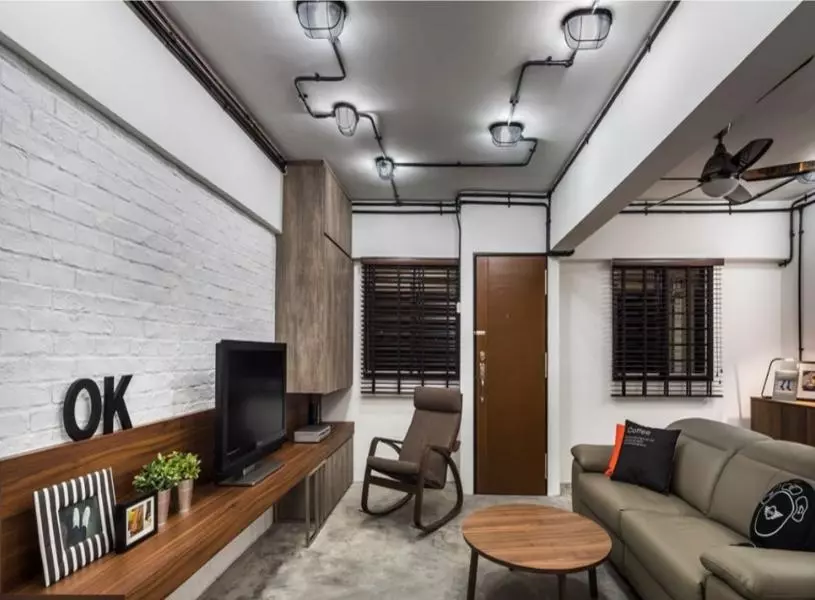Industrial interior design has skyrocketed in popularity, alongside contemporary and mid-century modern styles. This unique design combines sleek modernism with a rustic charm, creating a captivating aesthetic. If you're looking to transform your space into an industrial haven, look no further. Adria Workshop is here to provide you with expert tips and insights on achieving the perfect blend of rustic and industrial decor!
What Defines Industrial Design Interior?
 *Modern industrial living room with an exposed ceiling and open windows. (Source: Internet)*
*Modern industrial living room with an exposed ceiling and open windows. (Source: Internet)*
The essence of industrial design interior lies in repurposed warehouses turned urban lofts. These spaces feature exposed architectural details like iron or wooden ceiling rafters, brick walls, cement flooring, ducting, and large windows. These elements provide a foundation for a rustic yet aesthetically pleasing style.
While minimalist and open, industrial design incorporates rustic materials in furniture and lighting accents, making it suitable for any living environment. Its unfinished look adds a unique and cutting-edge touch to any space.
Industrial Style Interior Design History
The roots of industrial-style interiors can be traced back to the Industrial Revolution. During this time, factories emerged, utilizing large machines and employing many workers. The architectural features of these factories influenced the development of the industrial design style.
- First Industrial Revolution: In the 1760s, mass production began in urban Europe and the US. Factory architecture featured grid-paned windows, lofted floors, open spaces, and exposed brick walls for fire safety.
- Second Industrial Revolution: By the 1870s, factories grew larger, incorporating exposed concrete and steel. Edison light bulbs were invented during this era, influencing the emergence of steampunk.
- Housing Difficulties in the 2000s: In the 2000s, housing shortages led to the conversion of factories into industrial loft apartments with open floor plans.
- Minimalism and Hygge Rise: Industrial interior design gained popularity due to its clean lines, minimalism, and use of raw materials. It complemented the comfortable and cozy nature of hygge, inspired by Scandinavian interior design.
5 Key Industrial Style Interior Design Characteristics
 *Neutral colors are typical in modern industrial design interiors. (Source: Internet)*
*Neutral colors are typical in modern industrial design interiors. (Source: Internet)*
Interior designers and architects often opt for the industrial aesthetic when working on projects in major metropolitan areas. This timeless style redefines conventional architecture. Here are five key characteristics of industrial design interior that can give your home a fresh, new look.
1. Primary Colors
Industrial spaces don't limit themselves to a single cool color palette. You'll find the entire color gamut, from pure white to black, with shades of browns and neutrals. Embrace these hues to bring an industrial touch to your space.
2. Industrial Materials
Industrial design pays homage to utilitarian objects found in factories. Steel or wooden structural elements, as well as unfinished walls, create a work of art within your space. Stainless steel, iron, aluminum, copper, glass, concrete, brick, and salvaged wood are all materials that can be embraced in industrial design. Leather and linen work exceptionally well for upholstery.
3. Natural Light
Large windows with black panes, reminiscent of factory-style grids, are a signature feature of industrial design. These windows not only provide ample natural light but also add character to your space.
4. Textured Surfaces
Texture is a crucial component of industrial design. Concrete, brick, hammered metal, and other naturally textured surfaces provide the raw and rugged feel associated with industrial aesthetics.
5. Open Floor Plans
Open floor plans are synonymous with industrial design. This layout seamlessly transitions between spaces, transforming a mundane area into a cozy and inviting home.
Tips for Decorating Industrial Design Interior
If you're looking to recreate the industrial design style in your own home, here are some tips to spark your creativity:
- Exposed Structural Elements: Keep the raw materials of your space intact by showcasing structural elements like steel beams, pipes, and ducts. This creates an authentic industrial feel.
- Vintage Furniture: Embrace the aesthetic of antique or historical furniture to add character to your space. Opt for worn brown leather sofas and mix and match wooden furniture in different colors for a laid-back vibe.
- Natural Textiles: Add cozy touches to your industrial design interior with natural textiles. Incorporate materials like worn leather or linen for a softer contrast against the harsh metal.
- Ample Natural Light: Large windows are key in industrial design. If possible, install loft-style framing in black to add an industrial touch and maximize natural light.
- Combining Metals: Don't shy away from mixing metals in your space. Blending warm and cool tones creates depth and sophistication in your industrial design interior.
17+ Modern Industrial Interior Design Ideas
Looking to revamp your space with an industrial aesthetic? Check out these stunning industrial interior design ideas:
In Conclusion
Industrial interior design is all about embracing raw and repurposed elements to create a captivating aesthetic. By adhering to the key characteristics and incorporating unique touches, you can transform your space into an industrial haven. Follow Adria Workshop for more home decor style ideas and stay up to date with the latest trends!









